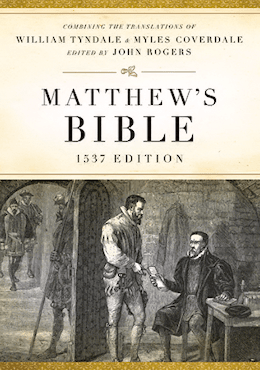Textus Receptus Bibles
Matthew's Bible 1537
| 4:1 | O how fayre arte thou, my loue, how fayre art thou? thou haste doues eyes, beside that whych lyeth hyd wythin. |
| 4:2 | They hearye lockes are lyke a flocke of shepe that be clipped, which go first vp from the washing place: where euery one beareth two twynes, and not one vnfruteful among them. |
| 4:3 | Thy lyppes are lyke a rose coloured rybonde, thy wordes are louely: thy chekes are like a pece of a pomgranate, besides that whych lyeth hyd wythin. |
| 4:4 | Thy necke is lyke the tower of Dauyd buylded wyth bulworkes, where vpon there hange a thousaunde shyldes, yea all the weapens of the gyauntes. |
| 4:5 | Thy two brestes are lyke two twins of yong roes, which fede among the lilies. |
| 4:6 | O that I myght go to the mountayne of Myrre, and to the hyll of franckincense: tyll the day breake, and tyl the shadowes be past awaye. |
| 4:7 | Thou arte all fayre, O my loue, and no spot is therin the. |
| 4:8 | Come to me from Lybanus, O my house, come to me from Libanus come soone the next way from the top of Amana, from the top of Sanir and Hermon, from the lyons dennes & from the mountaynes of the leopardes. |
| 4:9 | Thou hast wounded my hert. O my syster, my spouse, thou hast wounded my hert, with one of thyne eyes, & wyth one cheyne of thy neck. |
| 4:10 | O howe fayre and louely are thy brestes, my syster, my spouse? Thy brestes are more pleasaunte then wyne, and the smell of thyne oyntmentes passeth al spices. |
| 4:11 | Thy lyps, O my spouse, drop as the hony combe, yea milcke and hony is vnder thy tonge, and the smel of thy garmentes is lyke the smell of frankyncense. |
| 4:12 | Thou arte a well kepte garden, O my syster, my spouse, thou art a well kepte waterspringe, a sealed well. |
| 4:13 | The frutes that sprute in the, are like a very Paradyse of pomegranates with swete frutes: |
| 4:14 | as Cypresse, Nardus, Saffron, Calmus, and all the trees of Libanus: Myrre, Aloes, and all the best spyces. |
| 4:15 | Thou art a well of gardens, a well of lyuyng waters, whyche reune doune from Libanus. |
| 4:16 | Vp thou Northwynde, come thou southwynde, & blowe vppon my garden, that the smell therof may be caryed on eueryside: yea that my beloued may come into my garden, and eate of the frutes and apples that grow therein. |

Matthew's Bible 1537
The Matthew Bible, also known as Matthew's Version, was first published in 1537 by John Rogers, under the pseudonym "Thomas Matthew". It combined the New Testament of William Tyndale, and as much of the Old Testament as he had been able to translate before being captured and put to death, with the translations of Myles Coverdale as to the balance of the Old Testament and the Apocrypha, except the Apocryphal Prayer of Manasses. It is thus a vital link in the main sequence of English Bible translations.